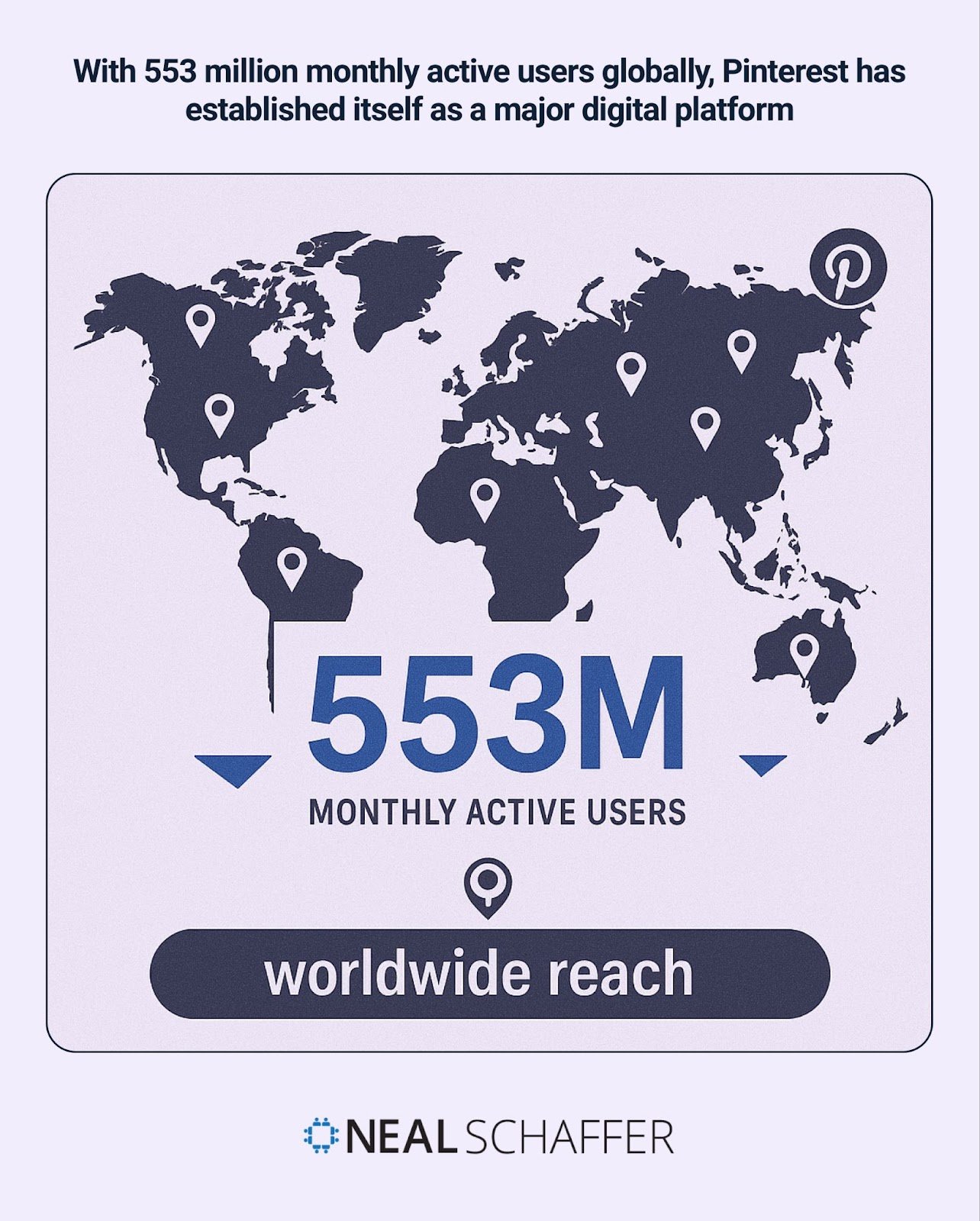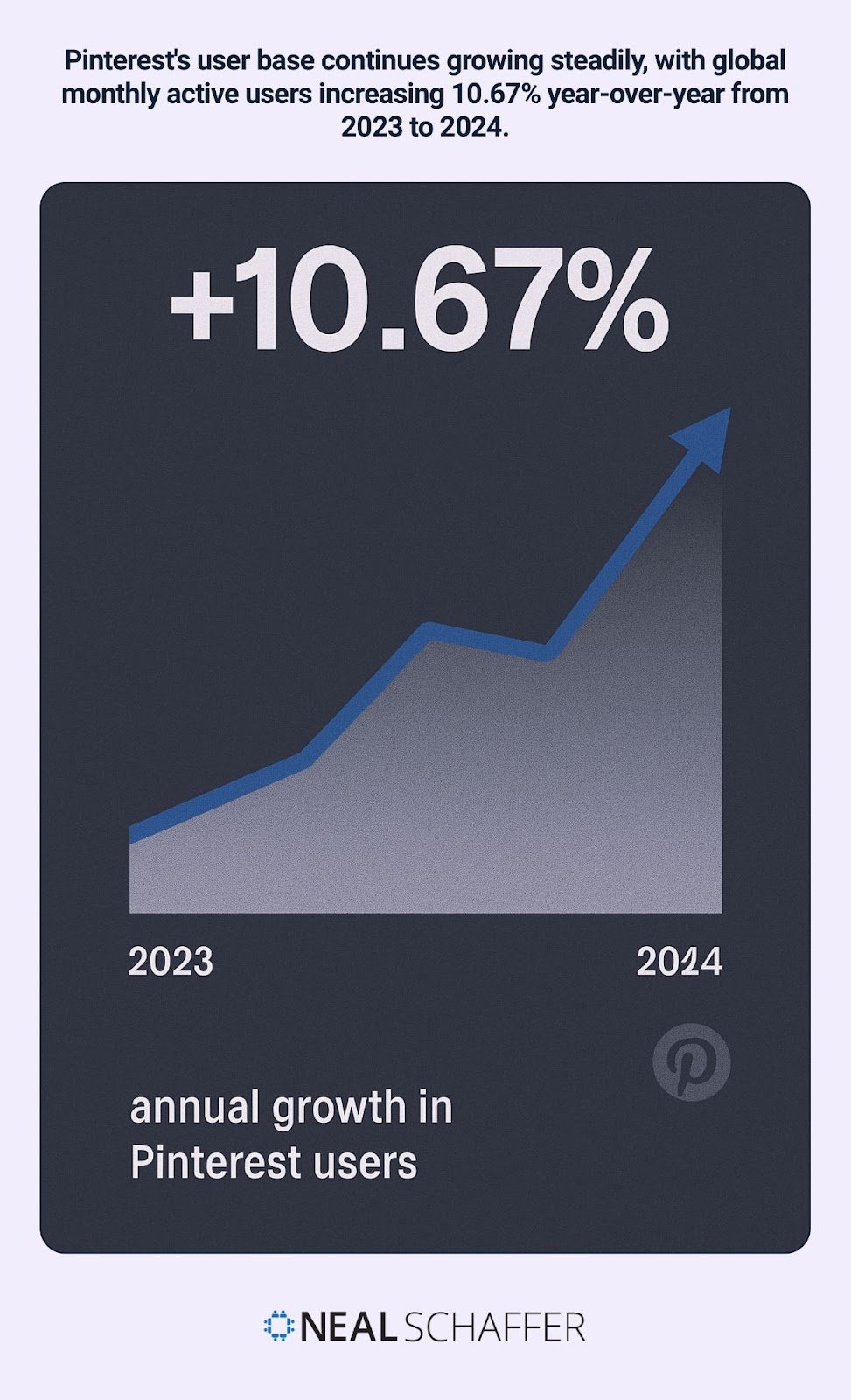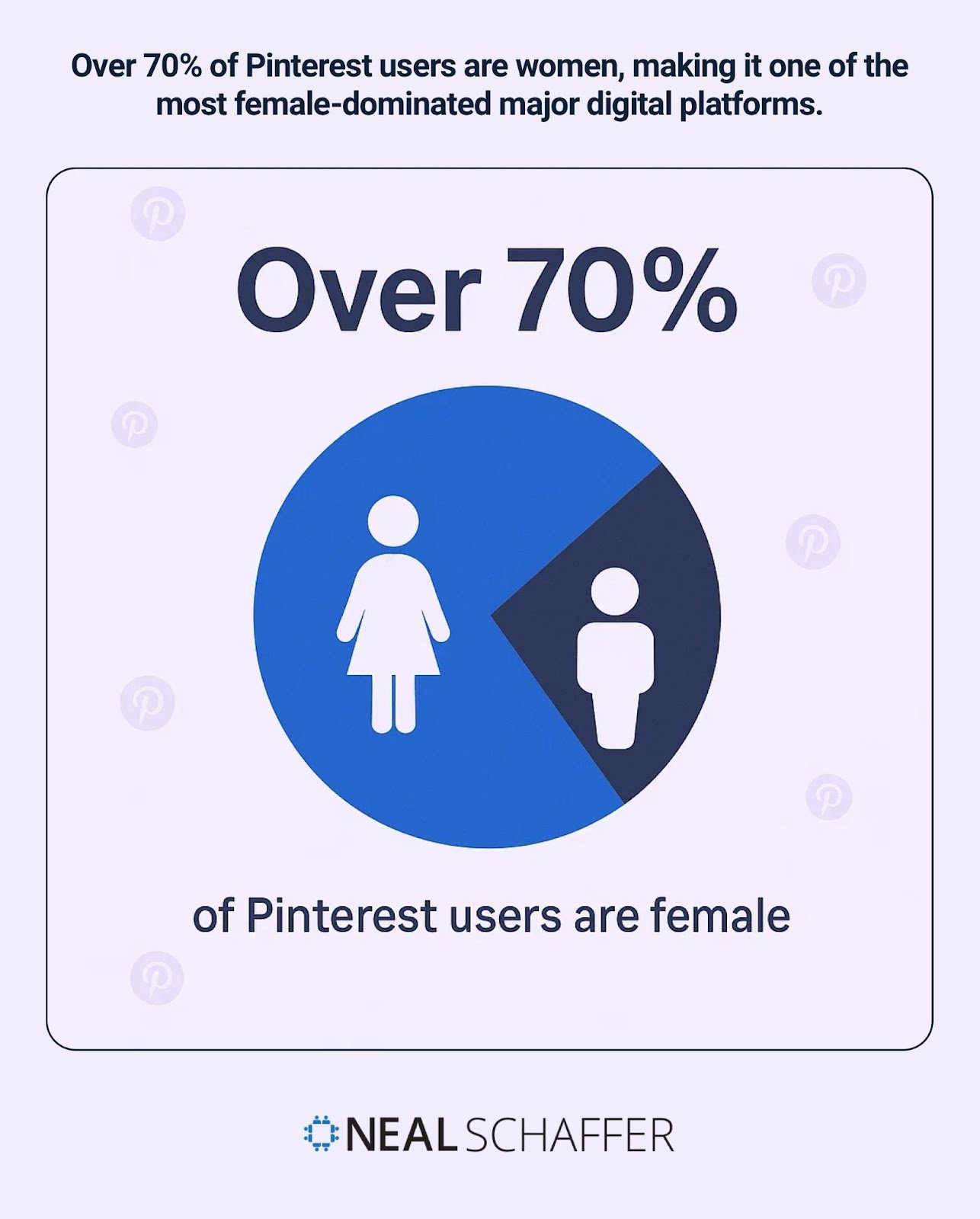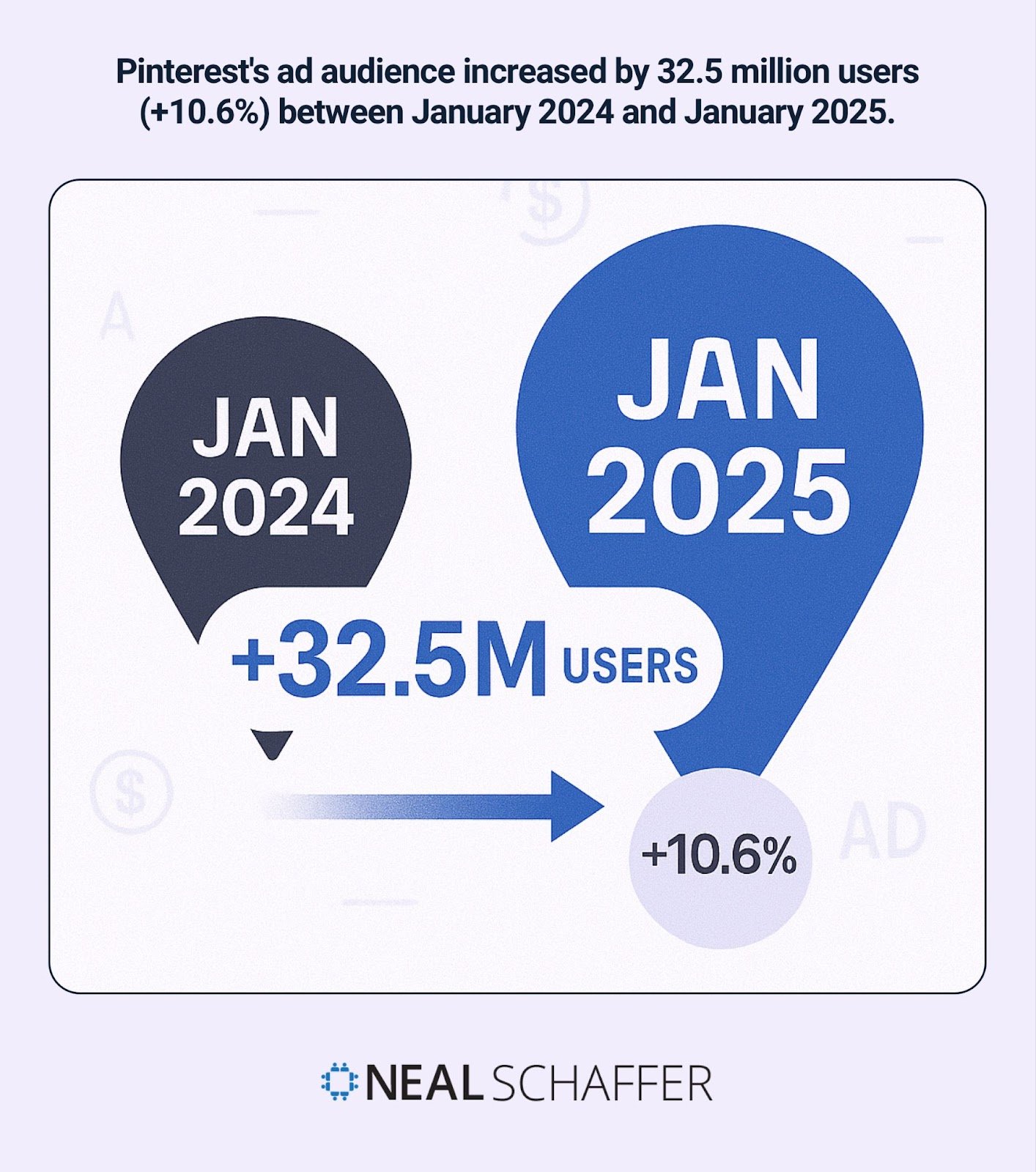Pinterest stands at an interesting crossroads in the digital world. It looks like a social platform, with profiles, following, and sharing. But it works more like a search engine in many ways. This unique position creates both confusion and opportunity for marketers trying to categorize and leverage it effectively.
This also helps to explain why Pinterest continues to drive the most traffic to this website from any social platform.

With 553 million monthly active users globally, Pinterest has established itself as a major digital platform. But does it truly qualify as social media? The answer impacts how businesses approach their Pinterest strategy.
Understanding Pinterest’s true nature helps marketers position their content correctly and set appropriate expectations for results. As someone who is an early adopter of Pinterest and often recommends the platform as part of a comprehensive social media marketing strategy, let’s examine what makes Pinterest unique, how it compares to traditional social media, and why its hybrid nature matters for your digital marketing strategy.
Before determining if Pinterest fits the social media category, we need clear criteria. Social media platforms primarily connect people with each other through shared content, conversations, and interactions. Their primary function is facilitating relationships and communication between users.
Traditional social media platforms like Facebook, Twitter, and Instagram focus on real-time content, direct user-to-user interactions, and building social connections. The content exists primarily as a means to foster engagement between people, with the social network itself being the primary product.
When evaluating whether a platform qualifies as social media, certain features typically appear across established social networks. These core elements define the social media experience and set these platforms apart from other digital destinations.
Traditional social media platforms generally include these key features:
- User profiles – Personal/business identities with customizable information
- Connection systems – Following, friending, or connecting with other users
- Activity feeds – Chronological or algorithm-based content streams
- Direct messaging – Private communication between users
- Real-time engagement – Likes, comments, shares on content
The core value proposition of these platforms centers on human connection and interaction. Content serves primarily as the conversation starter rather than being the main product itself.
Pinterest’s Core Functionality
Pinterest functions differently from traditional social networks from its fundamental design. It describes itself as a “visual discovery engine” rather than a social network. This distinction appears in both how the platform works and how users engage with it.
At its heart, Pinterest revolves around collecting and organizing visual content. Pinterest users create boards (collections) and save pins (visual bookmarks) organized by topics, projects, or interests. This system prioritizes content discovery and collection over social interaction.
The Visual Discovery Engine
Pinterest’s core experience centers on finding and saving visual ideas. When you search on Pinterest, it returns a visual grid of images (pins) related to your query, similar to a search engine rather than a social feed. This design fundamentally changes how content flows through the system.
Unlike chronological or purely algorithmic feeds on traditional social media, Pinterest organizes content primarily by relevance to search queries and browsing history. This creates an experience more similar to using Google Images than scrolling through Instagram or Facebook.
| Element | Pinterest Term | Functionality |
|---|
| Content Unit | Pin | Visual bookmark linking to external content or standalone idea |
| Collection | Board | Topical grouping of related pins |
| Discovery | Home Feed | Algorithmically curated pins based on interests and activity |
| Organization | Sections | Sub-categories within boards for further organization |
This structural approach creates a fundamentally different user experience focused on discovering and saving content rather than interacting with other users.
User Experience on Pinterest
People come to Pinterest with distinctly different intentions than when they visit Facebook or Twitter. They typically arrive with project-oriented mindsets, looking for inspiration, ideas, or solutions. This intent-driven usage creates a different relationship with the platform.
Pinterest users often express that they use the platform not to connect with friends but to connect with their own interests and aspirations. This inward-focused experience differs significantly from the outward social connection prioritized on traditional social media.
Social Elements of Pinterest
Despite its search-focused nature, Pinterest does incorporate several social features. These elements allow for connection and interaction between users, though they typically play a secondary role to content discovery and collection.
The social layer of Pinterest exists as an enhancement rather than the core purpose of the platform. This creates a subtle but important distinction in how social interactions function within the Pinterest ecosystem.
Community and Interaction Features
Pinterest includes several features that enable social interaction, though they’re less prominent than on traditional social networks. These features provide ways for users to connect while maintaining the platform’s focus on visual discovery.
Social capabilities on Pinterest include:
Is Your LinkedIn Not Delivering Results?
Just released: my new book to help professionals, entrepreneurs, and business owners maximize LinkedIn for real growth.
With years of LinkedIn expertise, Maximizing LinkedIn for Business Growth offers actionable steps to build your brand, expand your network, and drive results.
Start leveraging LinkedIn like never before—grab your copy now! Click the cover or button below to buy on Amazon.
- Following – Users can follow specific accounts or boards
- Collaborative boards – Multiple users can save pins to shared collections
- Comments – Limited commenting is available on pins
- Reactions – Users can react to pins with predefined responses
- Sharing – Content can be shared on Pinterest or to other platforms
While these features exist, they receive significantly less usage than the core pinning and saving functions that define the platform’s primary activity.
The Pinterest Algorithm
Unlike traditional social media algorithms that prioritize content based on social connections and engagement, Pinterest’s algorithm focuses primarily on content relevance to user interests. This creates a feed that resembles personalized search results more than a social timeline.
The Pinterest algorithm prioritizes factors like: content quality, topic relevance to user’s demonstrated interests, recency (though less than other platforms), and previous engagement patterns. Social signals like who created the content play a much smaller role than on platforms like Instagram or TikTok.
When comparing Pinterest to mainstream social media platforms, several key differences emerge. These distinctions help explain why Pinterest occupies a unique position in the digital ecosystem and why it requires different strategic approaches for marketers.
The fundamental differences stem from user intent, content lifespan, and the core value proposition of each platform type. Understanding these differences helps clarify whether Pinterest truly fits the social media category.
| Characteristic | Traditional Social Media | Pinterest |
|---|
| Core Purpose | Connect people with people | Connect people with ideas |
| Content Longevity | Short-lived (hours to days) | Long-lived (months to years) |
| Primary User Intent | Social connection, entertainment | Inspiration, planning, shopping |
| Content Organization | Chronological or engagement-based | Topical and interest-based |
| Traffic Generation | Primarily keeps users on-platform | Drives significant off-platform traffic |
These fundamental differences create a user experience that diverges significantly from what we typically associate with social media platforms.
Search Intent vs. Social Intent
The clearest distinction between Pinterest and traditional social media lies in user intent. People visit Facebook or Instagram to see what friends are doing, catch up on personal updates, or engage in conversations. The social interaction itself is the primary goal.
On Pinterest, users arrive with specific discovery goals – finding recipes, planning a wedding, researching home decor ideas, or searching for fashion inspiration. This intent-driven behavior resembles search engine usage more than social networking.
This difference in intent shifts how content works on the platform. On Pinterest, content quality and relevance to specific interests matter more than who created it or how many likes it has. This creates a fundamentally different environment for content strategy.
Content Longevity and Performance
Perhaps the most striking difference between Pinterest and traditional social platforms is content lifespan. While social media posts typically have a short half-life (24-48 hours or less), Pinterest pins can continue generating engagement, traffic, and conversions for months or even years.
This extended content lifespan creates a completely different value proposition for content creators and marketers. Pinterest resembles SEO more than social media management in terms of how content investments compound over time rather than requiring constant new production.
For businesses, this longevity means Pinterest content can deliver ongoing returns that most social media content cannot match. It also means the platform rewards quality and utility over recency or trending topics.
Pinterest User Demographics and Statistics
Understanding who uses the platform and other Pinterest statistics provides important context for determining its role in digital marketing strategy. The platform has a distinctive user profile that differs from many other major digital platforms in significant ways.

Pinterest’s user base continues growing steadily, with global monthly active users increasing 10.67% year-over-year from 2023 to 2024. This growth indicates Pinterest maintains relevance in an increasingly crowded digital landscape.
| Statistic | Value | Source |
|---|
| Global Monthly Active Users | 553 million | Pinterest Business |
| Ad Audience Reach | 340 million | DataReportal |
| U.S. Monthly Active Users | 90 million | Growth Devil |
| International User Percentage | 83% (432 million users) | Growth Devil |
| Global Ranking Among Platforms | 15th largest social platform | Growth Devil |
These numbers place Pinterest among the major digital platforms, though with a different usage pattern than platforms with similar user counts.
Who Uses Pinterest?
Pinterest has a distinctive demographic profile that sets it apart from many other digital platforms. The most striking characteristic is its gender distribution, with women making up the majority of active users.

Over 70% of Pinterest users are women, making it one of the most female-dominated major digital platforms. This gender skew creates both opportunities and considerations for marketers targeting specific audience demographics.
Beyond gender, Pinterest users typically have higher-than-average household incomes and education levels compared to users of many other platforms. The audience tends to be particularly strong among millennials, parents, and shoppers with disposable income.
Growth and Engagement Trends
Pinterest’s growth patterns reveal important insights about its position in the digital ecosystem. Unlike some social media platforms that experience rapid growth followed by plateaus or declines, Pinterest has maintained steady, sustainable growth over time.

Pinterest’s ad audience increased by 32.5 million users (+10.6%) between January 2024 and January 2025. This growth rate demonstrates continued expansion of the platform’s commercial reach.
The international component of Pinterest’s growth deserves special attention. With 83% of users now residing outside the U.S., Pinterest has transformed from a primarily American platform to a truly global one. This international expansion opens new opportunities for businesses targeting global markets.
Pinterest’s Role in Digital Marketing
Pinterest occupies a unique position in the marketing ecosystem. Its hybrid nature as part social platform and part visual search engine creates distinctive opportunities for brands that understand how to leverage its unique characteristics.
For businesses, Pinterest functions differently than traditional social media platforms in terms of content strategy, audience engagement, and performance measurement. It requires approaches that blend social media, SEO, and visual marketing principles.
Pinterest for Business Features
Pinterest offers specific tools (and here’s a list of external tools that can help your Pinterest marketing) and features designed for business users that facilitate marketing and commerce on the platform. These business-focused capabilities help brands maximize their presence and results on Pinterest.
Understanding the full range of business capabilities helps determine whether Pinterest fits into your marketing strategy and how to position it within your broader digital marketing approach.
| Feature Category | Key Capabilities | Marketing Value |
|---|
| Business Profile | Branded profile, verification, website claiming | Establishes official brand presence and credibility |
| Analytics | Audience insights, performance metrics, conversion tracking | Measures impact and optimizes content strategy |
| Advertising | Promoted pins, shopping ads, video ads | Expands reach and drives specific business actions |
| Shopping | Product pins, catalogs, shopping integration | Creates direct path to purchase from inspiration |
| Creation Tools | Pin builder, video pins, idea pins | Facilitates production of platform-optimized content |
These business-specific features reveal how Pinterest has evolved to support commercial activities while maintaining its core discovery functionality.
Pinterest Advertising Options
Pinterest’s advertising system differs from typical social media advertising platforms in several important ways. These differences stem from the platform’s unique position between social network and search engine.
Pinterest ads benefit from the platform’s intent-driven nature. Users often come to Pinterest actively planning purchases or projects, creating a receptive environment for relevant commercial content. This intent-driven audience can deliver strong conversion performance for appropriate products and services.
Key advertising formats on Pinterest include:
- Standard Pins – Single-image ads that appear in search results and feeds
- Video Pins – Motion-based content that auto-plays in feeds
- Shopping Pins – Product-focused ads with pricing and availability
- Carousel Pins – Multi-image ads that users can swipe through
- Collection Pins – Featured image with product thumbnails below
These ad formats integrate naturally into the Pinterest experience, appearing alongside organic content in ways that feel less disruptive than ads on many other platforms.
Strategic Approaches to Pinterest Marketing
Developing an effective Pinterest strategy requires understanding its unique position between social media and search engine. Successful Pinterest marketing blends elements from both disciplines while respecting the platform’s distinctive user behavior patterns.
The most effective Pinterest strategies acknowledge that users come to the platform with different intents than when visiting Facebook, Instagram, or TikTok. Content and engagement approaches must align with these different user expectations.
Content Strategy for Pinterest
Pinterest content strategy differs significantly from approaches that work on traditional social media platforms. The content that performs best on Pinterest aligns with how people use the platform for inspiration, planning, and problem-solving.
Creating effective Pinterest content requires a deeper understanding of what types of content resonate with Pinterest users. The platform rewards certain content characteristics that may not matter as much on other platforms.
High-performing Pinterest content typically includes these elements:
- Valuable information – Tutorials, guides, recipes, how-tos
- Visual quality – Clear, attractive images with good lighting
- Vertical format – 2:3 aspect ratio that optimizes screen space
- Text overlay – Clear, readable text that explains the content
- Seasonal relevance – Content aligned with upcoming events/seasons
Unlike typical social content focused on timeliness or personality, Pinterest content should emphasize utility, inspiration, and clear visual communication of ideas. Content that teaches, inspires, or solves problems typically outperforms purely entertaining content.
Measuring Success on Pinterest
Evaluating Pinterest performance requires metrics aligned with the platform’s unique position and user behavior patterns. Using the same KPIs you’d apply to Instagram or Facebook often leads to incorrect conclusions about Pinterest’s effectiveness.
The longer content lifespan on Pinterest means performance should be measured over extended periods – months rather than days. Early performance often understates the eventual total impact of Pinterest content as it continues generating results over time.
After examining Pinterest’s features, functionality, and usage patterns, we can now address the central question more clearly: Does Pinterest qualify as social media? The answer lies in how we define social media platforms and what characteristics we consider essential to the category.
By traditional definitions focusing on user-to-user interaction as the primary function, Pinterest falls short of being a pure social media platform. Its core purpose of connecting users with ideas rather than with each other creates a fundamentally different experience than platforms like Instagram or TikTok.
Perhaps the most accurate way to understand Pinterest is as a hybrid platform that combines elements of social media, visual search engines, and bookmarking tools. This hybrid nature makes it difficult to categorize but explains why it occupies a unique and valuable position in the digital marketing landscape.
Many digital platforms now exist along a spectrum rather than fitting neatly into single categories. Pinterest sits somewhere between pure search (Google) and pure social (Facebook), with elements of both but a distinctive identity of its own.
For marketers, the most productive approach is not trying to force Pinterest into existing categories but understanding its unique characteristics and how they align with specific marketing goals. The platform’s hybrid nature creates distinctive opportunities when used appropriately.

Conclusion
Pinterest defies simple categorization in the digital ecosystem. While it incorporates certain social elements, its primary function as a visual discovery engine sets it apart from traditional social media platforms. The defining characteristics of Pinterest – intent-driven usage, long content lifespan, and idea-centric rather than people-centric interactions – create a unique digital experience.
For marketers, this unique position creates both challenges and opportunities. Pinterest requires different strategic approaches than pure social media platforms, with content strategies that blend aspects of SEO, visual marketing, and social engagement. When leveraged appropriately, Pinterest’s hybrid nature can deliver value that purely social platforms cannot match, particularly for brands in visual categories like fashion, home decor, food, and lifestyle.
Rather than debating whether Pinterest qualifies as social media, the more productive approach is understanding its distinctive characteristics and how they align with your marketing objectives. By recognizing Pinterest as a category-defying platform and developing strategies tailored to its unique attributes, marketers can unlock its full potential as part of a comprehensive digital marketing approach.
Actionable advice for your digital / content / influencer / social media marketing.
Join 13,000+ smart professionals who subscribe to my regular updates.